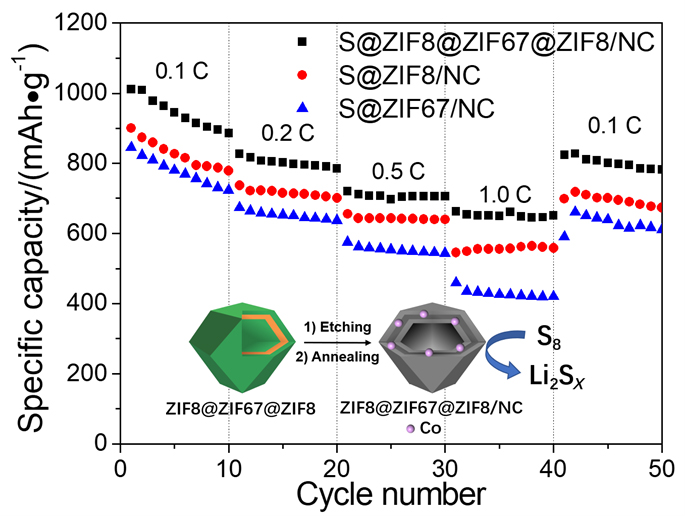| [1] |
Li, X.; Sun, X. L. Adv. Mater. 2018, 28, 1801323.
|
| [2] |
Yin, Y.-X.; Xin, S.; Guo, Y.-G.; Wan, L.-J. Angew. Chem. Int. Ed. 2013, 52, 13186.
doi: 10.1002/anie.201304762
|
| [3] |
Fu, A.; Wang, C.; Pei, F.; Cui, J.; Fang, X.; Zheng, N. Small 2019, 15, 1804786.
|
| [4] |
Wang, X.; Li, Y. B.; Du, L. Y.; Gao, F. J.; Wu, Q.; Yang, L. J.; Chen, Q.; Wang, X. Z.; Hu, Z. Acta Chim. Sinica 2018, 76, 627. (in Chinese)
doi: 10.6023/A18040135
|
|
(王啸, 李有彬, 杜玲玉, 高福杰, 吴强, 杨立军, 陈强, 王喜章, 胡征, 化学学报, 2018, 76, 627.)
doi: 10.6023/A18040135
|
| [5] |
Fang, R. P.; Zhao, S. Y.; Sun, Z. H.; Wang, W.; Cheng, H. M.; Li, F. Adv. Mater. 2017, 29, 1606823.
doi: 10.1002/adma.201606823
|
| [6] |
Diao, Y.; Xie, K.; Hong, X. B.; Xiong, S. Z. Acta Chim. Sinica 2013, 71, 508. (in Chinese)
doi: 10.6023/A12121024
|
|
(刁岩, 谢凯, 洪晓斌, 熊仕昭, 化学学报, 2013, 71, 508.)
doi: 10.6023/A12121024
|
| [7] |
Cheng, X.; Shen, Z.; Jiao, L.; Yang, L.; Wang, X.; Wu, Q.; Hu, Z. EnergyChem 2021, 3, 100066.
doi: 10.1016/j.enchem.2021.100066
|
| [8] |
Dai, L.; Chang, D. W.; Baek, J.-B.; Lu, W. Small 2012, 8, 1130.
doi: 10.1002/smll.201101594
|
| [9] |
Wu, Q.; Yang, L.; Wang, X.; Hu, Z. Sci. China Chem. 2020, 63, 665.
doi: 10.1007/s11426-020-9748-0
|
| [10] |
Wu, Q.; Yang, L.; Wang, X.; Hu, Z. Adv. Mater. 2020, 32, 1904177.
|
| [11] |
Hu, Z.; Wu, Q.; Chen, Y. Q. In Frontiers of Advanced Materials Research in China: Annual Report (2021), Chemical Industry Press, Beijing, 2021, Chapter 9. (in Chinese)
|
|
(胡征, 吴强, 陈轶群, 中国新材料研究前沿报告(2021), 化学工业出版社, 北京, 2021, 第九章)
|
| [12] |
Wu, Q.; Yang, L.; Wang, X.; Hu, Z. Acc. Chem. Res. 2017, 50, 435.
doi: 10.1021/acs.accounts.6b00541
|
| [13] |
Zhang, J.; Wang, K.; Guo, S.; Wang, S.; Liang, Z.; Chen, Z.; Fu, J.; Xu, Q. ACS Appl. Mater. Interfaces 2014, 6, 2192.
doi: 10.1021/am405375s
|
| [14] |
Lyu, Z.; Xu, D.; Yang, L.; Che, R.; Feng, R.; Zhao, J.; Li, Y.; Wu, Q.; Wang, X.; Hu, Z. Nano Energy 2015, 12, 657.
doi: 10.1016/j.nanoen.2015.01.033
|
| [15] |
Wang, L. W.; Feng, R.; Xia, J. Z.; Chen, S.; Wu, Q.; Yang, L. J.; Wang, X. Z.; Hu, Z. Acta Chim. Sinica 2014, 72, 1070. (in Chinese)
doi: 10.6023/A14050409
|
|
(王立伟, 冯瑞, 夏婧竹, 陈盛, 吴强, 杨立军, 王喜章, 胡征, 化学学报, 2014, 72, 1070.)
doi: 10.6023/A14050409
|
| [16] |
Han, J.; Xu, G.; Ding, B.; Pan, J.; Dou, H.; MacFarlane, D. R. J. Mater. Chem. A 2014, 2, 5352.
doi: 10.1039/C3TA15271E
|
| [17] |
Fang, X.; Zang, J.; Wang, X.; Zheng, M.-S.; Zheng, N. J. Mater. Chem. A 2014, 2, 6191.
doi: 10.1039/c3ta14881e
|
| [18] |
Ke, F. S.; Wu, Y. S.; Deng, H. J. Solid State Chem. 2015, 223, 109.
doi: 10.1016/j.jssc.2014.07.008
|
| [19] |
Jiang, H.; Liu, X. C.; Wu, Y.; Shu, Y.; Gong, X.; Ke, F. S.; Deng, H. Angew. Chem. Int. Ed. 2018, 57, 3916.
doi: 10.1002/anie.201712872
|
| [20] |
Wu, Y.; Jiang, H.; Ke, F. S.; Deng, H. Chem. Asian J. 2019, 14, 3577.
doi: 10.1002/asia.201900848
|
| [21] |
Yang, S. J.; Kim, T.; Im, J. H.; Kim, Y. S.; Lee, K.; Jung, H.; Park, C. R. Chem. Mater. 2012, 24, 464.
doi: 10.1021/cm202554j
|
| [22] |
Song, X. K.; Guo, L. L.; Liao, X. M.; Liu, J.; Sun, J. H.; Li, X. P. Small 2017, 13, 1700238.
doi: 10.1002/smll.201700238
|
| [23] |
Guan, B. Y.; Yu, L.; Lou, X. W. Adv. Sci. 2017, 4, 1700247.
doi: 10.1002/advs.201700247
|
| [24] |
Xiao, J.; Zhao, C.; Hu, C.; Xi, J.; Wang, S. J. Power Sources 2017, 348, 183.
doi: 10.1016/j.jpowsour.2017.03.011
|
| [25] |
Liu, S.; Wang, Z.; Zhou, S.; Yu, F.; Yu, M.; Chiang, C.-Y.; Zhou, W.; Zhao, J.; Qiu, J. Adv. Mater. 2017, 29, 1700874.
doi: 10.1002/adma.201700874
|
| [26] |
Liu, C.; Huang, X.; Wang, J.; Song, H.; Yang, Y.; Liu, Y.; Li, J.; Wang, L.; Yu, C. Adv. Funct. Mater. 2018, 28, 1705253.
doi: 10.1002/adfm.201705253
|
| [27] |
Wang, M. J.; Mao, Z. X.; Liu, L.; Peng, L.; Yang, N.; Deng, J.; Ding, W.; Li, J.; Wei, Z. Small 2018, 14, 1804183.
doi: 10.1002/smll.201804183
|
| [28] |
Zhang, W.; Jiang, X.; Zhao, Y.; Carne-Sanchez, A.; Malgras, V.; Kim, J.; Kim, J. H.; Wang, S.; Liu, J.; Jiang, J. S.; Yamauchi, Y.; Hu, M. Chem. Sci. 2017, 8, 3538.
doi: 10.1039/c6sc04903f
pmid: 28580098
|
| [29] |
Abdul Nasir Khan, M.; Kwame Klu, P.; Wang, C.; Zhang, W.; Luo, R.; Zhang, M.; Qi, J.; Sun, X.; Wang, L.; Li, J. Chem. Eng. J. 2019, 363, 234.
doi: 10.1016/j.cej.2019.01.129
|
| [30] |
Wang, Q.; Zhang, Z.; Shi, S.; Wu, F.; Zhang, Z.; Li, G.; Suo, Y. J. Electroanal. Chem. 2021, 894, 115397.
doi: 10.1016/j.jelechem.2021.115397
|
| [31] |
Wu, H.; Qian, X.; Zhu, H.; Ma, S.; Zhu, G.; Long, Y. RSC Adv. 2016, 6, 6915.
doi: 10.1039/C5RA18557B
|
| [32] |
Zhang, H.; Hwang, S.; Wang, M.; Feng, Z.; Karakalos, S.; Luo, L.; Qiao, Z.; Xie, X.; Wang, C.; Su, D.; Shao, Y.; Wu, G. J. Am. Chem. Soc. 2017, 139, 14143.
doi: 10.1021/jacs.7b06514
|
| [33] |
Chen, H.; Shen, K.; Tan, Y.; Li, Y. ACS Nano 2019, 13, 7800.
doi: 10.1021/acsnano.9b01953
|
| [34] |
Tang, J.; Salunkhe, R. R.; Liu, J.; Torad, N. L.; Imura, M.; Furukawa, S.; Yamauchi, Y. J. Am. Chem. Soc. 2015, 137, 1572.
doi: 10.1021/ja511539a
|
 ), 王喜章, 杨立军, 胡征*(
), 王喜章, 杨立军, 胡征*( )
)
 ), Xizhang Wang, Lijun Yang, Zheng Hu(
), Xizhang Wang, Lijun Yang, Zheng Hu( )
)
